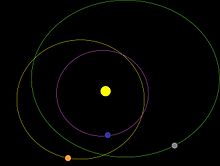58534 Logos
 Logos and its companion Zoe imaged by the Hubble Space Telescope in 2004 | |
| Discovery | |
|---|---|
| Discovered by | Mauna Kea Obs. (team disc.) |
| Discovery site | Mauna Kea Obs. |
| Discovery date | 4 February 1997 |
| Designations | |
| (58534) Logos | |
| Pronunciation | /ˈloʊɡɒs/ or /ˈlɒɡɒs/ |
Named after | Logos [1] (Aeon in Ptolemy Gnostics) |
| 1997 CQ29 | |
| TNO [1] · cubewano [2] cold [3] | |
| Adjectives | Logian /ˈlɒdʒiən/[4] |
| Orbital characteristics[1] | |
| Epoch 13 January 2016 (JD 2457400.5) | |
| Uncertainty parameter 3 | |
| Observation arc | 5582 days (15.28 yr) |
| Aphelion | 51.153 AU (7.6524 Tm) |
| Perihelion | 39.945 AU (5.9757 Tm) |
| 45.549 AU (6.8140 Tm) | |
| Eccentricity | 0.12304 |
| 307.42 yr (112284 d) | |
| 56.495° | |
| 0° 0m 11.542s / day | |
| Inclination | 2.8946° |
| 132.491° | |
| 339.21° | |
| Known satellites | Zoe (est. D: 66 km)[5] |
| Physical characteristics | |
| 77±18 km[6] | |
| Mass | 2.7×1017 kg |
Mean density | 1.0 g/cm3 |
| 0.39 ± 0.17[6] | |
| 6.6[1] | |
58534 Logos, or as a binary system (58534) Logos-Zoe,[7] is a trans-Neptunian object and binary system from the classical Kuiper belt, approximately 77 kilometers (48 miles) in diameter. The bright cubewano belongs to the cold population and has a 66-kilometer (41 miles) sized companion named Zoe.[6] The system mass is (4.58±0.07)×1017 kg.[7]
In the Gnostic tradition, Logos and Zoe are a paired emanation of the deity, and part of its creation myth.[1]
Zoe
 Two bodies with similar mass orbiting around a common barycenter (red cross) with elliptic orbits. The interaction of Logos and Zoe is similar to this. | |
| Discovery | |
|---|---|
| Discovered by | Keith S. Noll et al. |
| Discovery date | 17 November 2001 |
| Designations | |
| Pronunciation | /ˈzoʊ.iː/ |
Named after | Zoe (Ζωή) |
| (58534) Logos I Zoe | |
| Adjectives | Zoean /zoʊˈiːən/) |
| Orbital characteristics[7] | |
| 8217 km | |
| Eccentricity | 0.546 |
| 309.9 d | |
| Satellite of | Logos |
| Physical characteristics[5] | |
| Dimensions | 66 km |
| Mass | (1.5±0.2)×1017 kg |
Logos is a binary with the components of comparable size orbiting the barycentre on a moderately elliptical orbit.
Logos was discovered on 4 February 1997, and its companion, Zoe, was discovered on 17 November 2001 from Hubble Space Telescope observations by K. S. Noll, D. C. Stephens, W. M. Grundy, J. Spencer, Robert Millis, Marc Buie, Dale Cruikshank, S. C. Tegler, and W. Romanishin and announced on 11 February 2002.
After the discovery, it received the provisional designation S/2001 (58534) 1. Once confirmed it was officially named (58534) Logos I Zoe. It orbits Logos with a semi-major axis of 8217 km in 309.9 days with an eccentricity of 0.546.[7] Its estimated diameter is 66 km,[5] and mass (0.15 ± 0.02)×1018 kg.
Orbit
A 10-million-year integration of the orbit shows that it is a Classical Kuiper belt object that does not get closer to the Sun than 38.8 AU (5.80 billion km) or further than 52.1 AU.[2]

References
- ^ a b c d e "58534 Logos (1997 CQ29)". JPL Small-Body Database. NASA/Jet Propulsion Laboratory. Retrieved 12 April 2016.
- ^ a b Marc W. Buie (31 May 2003). "Orbit Fit and Astrometric record for 58534". SwRI (Space Science Department).
- ^ Brown, Mike. "How many dwarf planets are there in the Solar System". Retrieved 17 February 2018.
- ^ "Logian". Oxford English Dictionary (Online ed.). Oxford University Press. (Subscription or participating institution membership required.)
- ^ a b c Wm. Robert Johnston (4 March 2007). "(58534) Logos and Zoe". Johnston's Archive.
- ^ a b c Grundy, W. M; Noll, K. S.; Stephens, D. C. (2005). "Diverse albedos of small trans-neptunian objects". Icarus. 176 (1): 184–191. arXiv:astro-ph/0502229. Bibcode:2005Icar..176..184G. doi:10.1016/j.icarus.2005.01.007. S2CID 118866288.
- ^ a b c d Grundy, W. M.; Noll, K. S.; Nimmo, F.; Roe, H. G.; Buie, M. W.; Porter, S. B.; Benecchi, S. D.; Stephens, D. C.; Levison, H. F.; Stansberry, J. A. (2011). "Five new and three improved mutual orbits of transneptunian binaries" (PDF). Icarus. 213 (2): 678. arXiv:1103.2751. Bibcode:2011Icar..213..678G. doi:10.1016/j.icarus.2011.03.012. S2CID 9571163.
External links
- IAUC 7824 Archived 2006-05-01 at the Wayback Machine – IAUC 7959
- 58534 Logos at AstDyS-2, Asteroids—Dynamic Site
- 58534 Logos at the JPL Small-Body Database